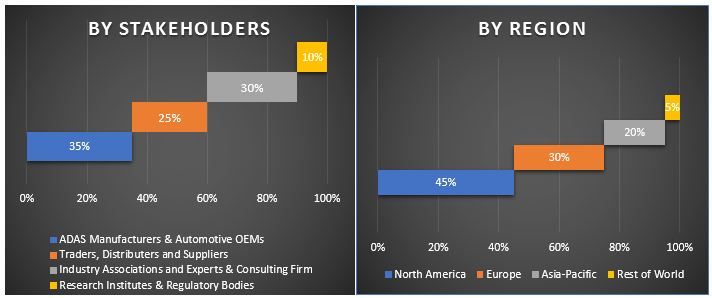- Home
- About Us
- Industry
- Services
- Reading
- Contact Us
Advanced Driver-Assistance Systems (ADAS) Market: Current Analysis and Forecast (2020-2026)
Emphasis on System Type (Adaptive Cruise Control (ACC), Intelligent Park Assist (IPA), Automatic Emergency Braking (AEB), Adaptive Front Light (AFL), Blind Spot Detection (BSD), Lane Departure Warning (LDW), Drowsiness Monitor System (DMS), Others), Sensor Type (Image Sensor, LiDAR Sensor, Ultrasonic Sensor, Radar Sensor, Other), Vehicle Type (Passenger Car, Light Commercial Vehicle, Heavy Commercial Vehicle), Distribution Channel (Original Equipment Manufacturer (OEMs), Aftermarket) and Region/Country
Advanced Driver Assistance Systems (ADAS) focus on the reduction of road accidents and the associated casualties by helping drivers avoid collisions altogether. These systems react faster than any human, are constantly vigilant, and are already being adopted and deployed across various car segments, from premium to economy models. ADAS systems constantly monitor the vehicle surroundings, alert the driver of hazardous road conditions, and take corrective actions, such as slowing or stopping the vehicle.
The demand for advanced driver-assistance systems (ADAS) that help with monitoring, warning, braking, and steering tasks is anticipated to increase soon, fueled largely by regulatory and consumer interest in safety applications that protect drivers and reduce accidents. For instance, both the European Union and the United States are mandating that all vehicles be equipped with autonomous emergency-braking systems and forward-collision warning systems by 2020.
Various semiconductor companies that have not traditionally participated in the automotive sector now offer ADAS products or are developing them. Automakers have devised their own branded technology names which, for example, has resulted in twenty unique names for adaptive cruise control and nineteen different names for lane keeping assistance. In addition to being widely available, the costs of driver assistance features are relatively affordable. For instance, the average price of Adaptive Cruise Control is US$ 1,174 as a stand-alone feature and US$ 2,283 in an ADAS bundle. The cost of an ADAS bundle is around US$ 1,950 on average according to SBD data. The average new vehicle cost for December 2017, as reported by Kelley Blue Book, was US$ 36,113. This makes the cost of an ADAS bundle approximately 5.4% of the total cost of the vehicle. The common ADAS features such as Adaptive Cruise Control, Blind Spot Warning, and Automatic Emergency Braking are available in at least 80% of vehicles in each of the Midsize, Large, and SUV vehicle segments. Lane Keeping Assistance is available in at least 60% of vehicles within 7 of 10 vehicle segments. These features are becoming standard equipment on many vehicles. For example, Automatic Emergency Braking is standard on 30.6% of all models, Lane Keeping Assistance on 13.9%, and Adaptive Cruise Control on 11.8%.
Burden of Road Injuries per Year
Robert Bosch GmbH, Continental AG, Autoliv Inc., Aptiv, Delphi Automotive Company, ZF Friedrichshafen, Denso Corporation, Hella KGAA Hueck & Co, Hyundai Mobis and Texas Instruments Inc are some of the prominent players operating in the global Advanced Driver-Assistance Systems market. Several M&A’s along with partnerships have been undertaken by these players to facilitate costumers with hi-tech and innovative products.
Insights Presented in the Report
“Amongst system type, adaptive cruise control segment holds the major share”
Based on system type, the market is fragmented into Adaptive Cruise Control (ACC), Intelligent Park Assist (IPA), Automatic Emergency Braking (AEB), Adaptive Front Light (AFL), Blind Spot Detection (BSD), Lane Departure Warning (LDW), Drowsiness Monitor System (DMS) and others. The intelligent park assist segment dominated the market with a share of 27.4% in 2019 and is expected to maintain its dominance during the forecast period owing to the increased consumer preference towards comfort and luxury, and increased competition between OEMs to offer such driver assistance features.
“Amongst sensor type, image sensor is expected to dominate the market during the analyzed period”
Based on the market segment by sensor type, the market is segmented into Image Sensor, LiDAR Sensor, Ultrasonic Sensor, Radar Sensor and others. In 2019, Image sensor accounted for 35.9% of market revenue share. Currently, image sensor dominated the Advanced Driver-Assistance Systems market and is expected to remain dominant during the analyzed period. The image sensors provide enhanced safety features on the road by offering features such as parking assistance, lane departure warnings, and collision avoidance systems.
“Amongst vehicle type, passenger vehicles are expected to dominate the market during the analyzed period”
Based on the market segment by vehicle type, the market is fragmented into passenger cars, light commercial vehicles and heavy commercial vehicle. In 2019, the passenger vehicles accounted for the maximum market share with 52.8% and is expected to be the leading segment of the Advanced Driver-Assistance Systems market during the forecast period. The new in-vehicle technologies under development have the potential to increase as well as decrease crash injury risk by introducing driver distraction and inadvertent behavioral change. The common ADAS features are available in at least 60-80% of vehicles in various midsize, large, and SUV vehicle segments.
“Amongst distribution channel, OEMs are expected to dominate the market during the analyzed period”
Based on the market segment by distribution channel, the market is fragmented into OEMs and aftermarket. In 2019, the OEMs accounted for the maximum market share with 79.1% and is anticipated to lead throughout the forecast period. The automotive companies are now developing new vehicles, electric powertrains, autonomous technologies and advanced safety systems at an unprecedented rate. The original-equipment manufacturers (OEMs) and their suppliers realize that they could eventually become the main feature differentiating automotive brands, as well as one of their most important revenue sources.
“North America represents one of the largest markets of Advanced Driver-Assistance Systems market”
For a better understanding of the market dynamics of the Advanced Driver-Assistance Systems market, a detailed analysis was conducted for different regions across the globe including North America (the U.S, Canada, and Rest of North America), Europe (Germany, France, Italy, Spain, United Kingdom and Rest of Europe), Asia-Pacific (China, Japan, India, Australia and Rest of APAC) and Rest of the World has been conducted. Europe dominated the market and generated revenue of US$ 11.3 billion in 2019. The market growth prospects are attributed to the presence of the world’s biggest automotive producers across the world. However, the APAC region is expected to witness the highest CAGR growth of 18.52% during the forecast period 2021-2026.
Reasons to buy this report:
- The study includes market sizing and forecasting analysis validated by authenticated key industry experts
- The report presents a quick review of overall industry performance at one glance
- The report covers in-depth analysis of prominent industry peers with a primary focus on key business financials, product portfolio, expansion strategies, and recent developments
- Detailed examination of drivers, restraints, key trends, and opportunities prevailing in the industry
- The study comprehensively covers the market across different segments
- Deep dive regional level analysis of the industry
Customization Options:
The Advanced Driver-Assistance Systems Market can further be customized as per the requirement or any other market segment. Besides this, UMI understands that you may have your own business needs, hence feel free to connect with us to get a report that completely suits your requirements.
Table of Content
Analyzing the historical market, estimation of the current market, and forecasting the future market of the Global Advanced Driver-Assistance Systems Market were the three major steps undertaken to create and analyze the adoption of Advanced Driver-Assistance Systems across automotive industry in major regions globally. Exhaustive secondary research was conducted to collect the historical market numbers and estimate the current market size. Secondly, to validate these insights, numerous findings and assumptions were taken into consideration. Moreover, exhaustive primary interviews were also conducted, with industry experts across the value chain of the Advanced Driver-Assistance Systems sector. Post assumption and validation of market numbers through primary interviews, we employed a top-down approach to forecast the complete market size. Thereafter, market breakdown and data triangulation methods were adopted to estimate and analyze the market size of segments and sub-segments the industry pertains to. Detailed methodology is explained below:
Analysis of Historical Market Size
Step 1: In-Depth Study of Secondary Sources:
Detail secondary study was conducted to obtain the historical market size of the Advanced Driver-Assistance Systems through company internal sources such as annual report & financial statements, performance presentations, press releases, etc., and external sources including journals, news & articles, government publications, competitor publications, sector reports, third-party database, and other credible publications.
Step 2: Market Segmentation:
After obtaining the historical market size of the Advanced Driver-Assistance Systems market, we conducted a detailed secondary analysis to gather historical market insights and share for different segments & sub-segments for major regions. Major segments included in the report as system type, sensor type, vehicle type and distribution channel. Further country-level analyses were conducted to evaluate the overall adoption of the Advanced Driver-Assistance Systems in that region.
Step 3: Factor Analysis:
After acquiring the historical market size of different segments and sub-segments, we conducted a detailed factor analysis to estimate the current market size of Advanced Driver-Assistance Systems. Further, we conducted factor analysis using dependent and independent variables such as rising demand for a safe, efficient and convenient driving, government mandates about vehicle safety among others. A thorough analysis was conducted for demand and supply-side scenario considering top partnerships, merger and acquisition, business expansion, and product launches in the Advanced Driver-Assistance Systems industry across the globe.
Current Market Size Estimate & Forecast
Current Market Sizing: Based on actionable insights from the above 3 steps, we arrived at the current market size, key players in the Advanced Driver-Assistance Systems market, and market shares of the segments. All the required percentage shares split, and market breakdowns were determined using the above-mentioned secondary approach and were verified through primary interviews.
Estimation & Forecasting: For market estimation and forecast, weights were assigned to different factors including drivers & trends, restraints, and opportunities available for the stakeholders. After analyzing these factors, relevant forecasting techniques i.e. top-down approach was applied to arrive at the market forecast about 2026 for different segments and subsegments across the major markets globally. The research methodology adopted to estimate the market size encompasses:
- The industry’s market size, in terms of value (US$) and the adoption rate of Advanced Driver-Assistance Systems across the major markets domestically
- All percentage shares, splits, and breakdowns of market segments and sub-segments
- Key players in the Advanced Driver-Assistance Systems market in terms of services offered. Also, the growth strategies adopted by these players to compete in the fast-growing market
Market Size and Share Validation
Primary Research: In-depth interviews were conducted with the Key Opinion Leaders (KOLs) including Top Level Executives (CXO/VPs, Sales Head, Marketing Head, Operational Head, and Regional Head, Country Head, etc.) across major regions. Primary research findings were then summarized, and statistical analysis was performed to prove the stated hypothesis. Inputs from primary research were consolidated with secondary findings, hence turning information into actionable insights.
Split of Primary Participants in Different Regions
Market Engineering
Data triangulation technique was employed to complete the overall market estimation and to arrive at precise statistical numbers of each segment and sub-segment of the Advanced Driver-Assistance Systems market. Data was split into several segments & sub-segments post studying various parameters and trends in the areas of system type, sensor type, vehicle type, and distribution channel of the Advanced Driver-Assistance Systems market.
The main objective of the Advanced Driver-Assistance Systems Market Study
The current & future market trends of Advanced Driver-Assistance Systems were pinpointed in the study. Investors can gain strategic insights to base their discretion for investments from the qualitative and quantitative analysis performed in the study. Current and future market trends were determined the overall attractiveness of the market at a regional level, providing a platform for the industrial participant to exploit the untapped market to benefit as a first-mover advantage. Other quantitative goals of the studies include:
- Analyze the current and forecast market size of Advanced Driver-Assistance Systems in terms of value (US$). Also, analyze the current and forecast market size of different segments and sub-segments
- Segments in the study include areas of system type, sensor type, vehicle type, and distribution channel
- Define and analysis of the regulatory framework for the Advanced Driver-Assistance Systems sector
- Analyze the value chain involved with the presence of various intermediaries, along with analyzing customer and competitor behaviors of the industry
- Analyze the current and forecast market size of the Advanced Driver-Assistance Systems market for the major region
- Major regions studied in the report include North America (the U.S and Canada), Europe (Germany, France, Italy, Spain, and United Kingdom), Asia-Pacific (China, Japan, India, South Korea, and Australia), and the Rest of the World
- Company profiles of the Advanced Driver-Assistance Systems market and the growth strategies adopted by the market players to sustain in the fast-growing market Deep dive regional level analysis of the industry
Related Reports
Customers who bought this item also bought













